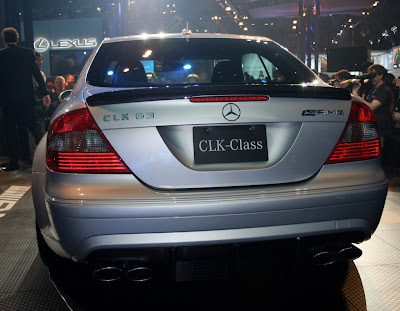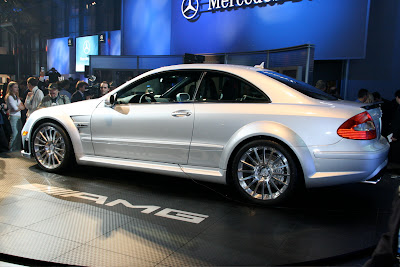Mercedes-Benz CLK63 AMG Black Series
标签: Mercedes-Benz 0 评论








Detailed content:
Mercedes-Benz CLK63 AMG Black series makes global debut "Street" Version of F1™ Safety Car Helps Celebrate 40 Years of AMG
NEW YORK – The Mercedes-Benz CLK63 AMG Black Series is making its global debut at the New York International Auto Show, open to the public April 6-15, 2007 at the Jacob Javits Convention Center in Manhattan. Teamed with the CL65 AMG 40th Anniversary edition (a larger coupe also being unveiled in New York), the CLK63 AMG Black Series coupe celebrates 40 years of AMG high-performance cars.
The CLK63 Black Series is a street legal version of the Official F1™ Safety Car, which borrows design and technology from the Formula One racing world. For starters, the Black Series is a 500 horsepower version of the AMG 6.3-liter V8 engine, with 0-60 mph acceleration of 4.1 seconds and an electronically limited top speed of 186 mph.
The new Black Series model can be easily identified by its carbon-fiber flared fenders that are filled with larger, staggered-width wheels and tires. New AMG forged aluminum wheels (9 x 19 front, 9.5 x 19 rear) are shod with Pirelli P Zero Corsa sports tires (265 / 30 R 19 front, 285 / 30 R 19 rear). Larger vented and perforated composite disc brakes can be seen through the AMG wheels; front discs are 14.2 inches in diameter, with 13.0-inch discs at the rear.
Also obvious from the outside is a new front apron with carbon cooling air intakes under the front bumper and lateral air outlets in the front fenders, which feeds extra air to a larger radiator and a second transmission oil cooler. Redesigned side skirts under the doors lead to its flared rear fenders and a new rear apron with carbon-fiber air diffuser fins.
High-performance parts from the F1 Safety Car include an AMG sports exhaust, a limited-slip rear differential and a separate oil cooler for the rear final drive, which uses a thermostatically controlled cooling fan to limit temperature peaks. On the trunk lid, a carbon-fiber spoiler airflow helps reduce aerodynamic lift forces at high speed.
Black Series Features Adjustable Suspension
The chassis of the Mercedes-Benz CLK63 AMG Black Series features adjustable suspension with new spring links, wheel carriers, thrust arms and camber and torque struts. For driving on the track, technicians can adjust the car's ride height and also the compression and rebound characteristics of the shock dampers, as well as camber and toe-in. An extra measure of chassis stiffness during hard cornering is provided by strut braces in the engine compartment and trunk. Additionally, its ASR traction control and ESP stability control systems are specially calibrated for the demands of more intense track driving.
More Power from the AMG V8
The Black Series engine comes with completely redesigned intake and exhaust systems. Larger intake ducts, a new AMG sport exhaust with full-length twin pipes and a recalibrated engine control unit provides even swifter throttle response, not to mention its 500-horsepower.
The Black Series model is powered by the first engine designed totally by AMG. One of the most powerful naturally aspirated production V8s ever, the new engine boasts a wealth of features derived from AMG's highly successful racing heritage. Built almost completely from a high-strength silicon-aluminum alloy, the 6.3-liter V8 features four valves per cylinder, variable valve timing, bucket followers (rather than rocker arms) and a variable intake manifold. The engine shares no parts with Mercedes-Benz V8 engines. A first for a production engine, the cylinder bores feature a twin-wire-arc-sprayed (TWAS) coating, a new process that results in impressively low friction and running surfaces that are twice as hard as conventional cast-iron cylinders.
Its seven-speed AMG SPEEDSHIFT transmission is coupled to a rear final drive that's about six percent "shorter" for more responsive acceleration. The automatic transmission has Manual and Sport driving programs (the comfort-oriented Comfort mode isn't included), and drivers can shift between the seven gears using aluminum shift paddles on the 14.1 inch DTM-style leather steering wheel. In the Manual mode, shift times are about 20 percent faster than in Sport, with no automatic downshifting or upshifting under full load and kickdown. Only an upshift icon on the AMG main menu in the dash signals recommended gear changes.
A High-Performance Interior
The F1-inspired design and technology of the CLK63 AMG Black Series is carried through to its high-tech interior. This dedicated two-seater sports touring car not only dispenses with rear seats, but its bucket-type seats, rich carbon fiber interior trim and black headliner also underscore the purposeful look of a true race car. The new AMG front seats are covered in nappa leather with embroidered silver AMG logos.
Its new AMG sport steering wheel is more than a half inch (15 mm) smaller and comes with aluminum shift paddles. Carbon fiber trim on the center console and instrument cluster (also stamped with AMG logos), underscore the car's competition roots. A specially contoured Aluminum shift lever and a new engine "start-stop" button add further touches.
About AMG
The abbreviation AMG stands for Hans-Werner Aufrecht (A) and his partner Erhard Melcher (M), who founded AMG in 1967, and Aufrecht's birthplace of Grossaspach (G). Both had been employees of Mercedes-Benz and officially described themselves as "engineering, design and testing specialists in the development of racing engines." The fledgling firm initially based itself in an old mill in Burgstall (near Affalterbach).
From its beginnings as an independent racing and tuning firm of Mercedes cars, Mercedes-AMG has grown into a supplier of exclusive high-performance cars, an extensive model range and customers around the world. In 1999, Aufrecht sold a majority shareholding in AMG, and the company was incorporated into DaimlerChrysler AG, allowing the newly founded Mercedes-AMG to benefit even more from DCAG's global resources.
An integral part of the Mercedes-Benz organization, Mercedes-AMG has become synonymous with factory-developed high-performance vehicles. Far more than a tuner or marketing division, Mercedes-AMG is a self-contained entity responsible for all aspects of its vehicles, from development and testing to marketing, with some aspects of production shared with Mercedes-Benz facilities. The highly specialized subsidiary has overall responsibility for the engine, transmission, chassis, brakes, aerodynamics, interior, design and sales and marketing of AMG cars. Growth of the Mercedes-AMG product line has included new production, development and showroom buildings in Affalterbach.
One Man, One Engine
Mercedes-AMG follows a philosophy of "one man, one engine." A single technician – identified by the signature plate affixed to each engine – is responsible for the complete assembly of an AMG high-performance engine from start to finish. Each engine is produced and tested at AMG's headquarters in Affalterbach, which produces 100 engines a day for the entire range of Mercedes-AMG vehicles. AMG models are then assembled at the main Mercedes-Benz vehicle assembly plants.
In addition to engine manufacturing, the new production facility is home to plant management, quality control, production planning, and ordering and parts logistics departments. AMG currently employs about 750 specialists in development, production and administrative areas.





0 评论: to “ Mercedes-Benz CLK63 AMG Black Series ”
Post a Comment